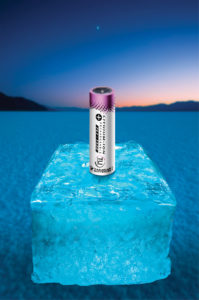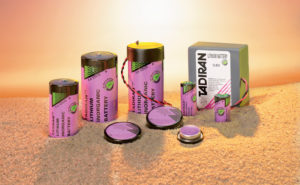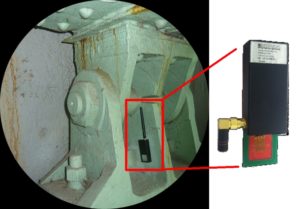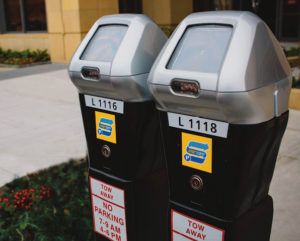Self-powered electronic devices that define the Industrial Internet of Things (IIoT) have special needs that can be addressed through the judicious selection of battery chemistry.
SOL JACOBS | TADIRAN BATTERIES
 Going ‘truly wireless’ typically necessitates the use of primary (non-rechargeable) or rechargeable lithium-ion (Li-ion) batteries. Besides untethering applications from ac lines, use of rechargeable batteries eliminates the need for hard-wiring, which costs roughly $100/ft. or more. And the cost of hard-wiring often skyrockets in industrial settings due to environmental, regulatory and permitting requirements.
Going ‘truly wireless’ typically necessitates the use of primary (non-rechargeable) or rechargeable lithium-ion (Li-ion) batteries. Besides untethering applications from ac lines, use of rechargeable batteries eliminates the need for hard-wiring, which costs roughly $100/ft. or more. And the cost of hard-wiring often skyrockets in industrial settings due to environmental, regulatory and permitting requirements.
Application requirements dictate the choice of battery. For example, a device that is easily accessible and that operates within a moderate temperature range may be able to suffice with a consumer grade battery. However, the low initial cost of consumer cells can end up making the total lifetime cost expensive. One reason: Total lifetime cost factors in all expenses associated with future battery replacements. Generally, the more remote the application, the greater the need for an industrial grade battery.
As the lightest non-gaseous metal, lithium offers the highest specific energy (energy per unit weight) and energy density (energy per unit volume) of any battery type. Lithium cells feature a normal operating current voltage (OCV) ranging from 2.7 to 3.6 V. Lithium chemistries are also non-aqueous, with the absence of water allowing certain cells to deliver an extended temperature range of –55 to 125°C.
Wireless devices that draw low average daily current are predominantly powered by bobbin-type lithium thionyl chloride (LiSOCl2) batteries that offer exceptional performance qualities, including the highest energy density, highest capacity, the widest temperature range, and extremely low annual self-discharge rate. These performance qualities permit the construction of small power sources having incredibly long operating lives. Certain cells can operate for up to 40 years.
 Standard bobbin-type LiSOCl2 cells are not designed to deliver high pulses, so they must be combined with a patented hybrid layer capacitor (HLC) to serve high-pulse applications. The standard LiSOCl2 cell delivers low background current to power the device in stand-by mode, while the HLC delivers the periodic high pulses necessary for wireless communications.
Standard bobbin-type LiSOCl2 cells are not designed to deliver high pulses, so they must be combined with a patented hybrid layer capacitor (HLC) to serve high-pulse applications. The standard LiSOCl2 cell delivers low background current to power the device in stand-by mode, while the HLC delivers the periodic high pulses necessary for wireless communications.
Consumer electronic devices often rely on supercapacitors to store the energy for high pulses in an electrostatic field rather than as chemical energy. However, supercapacitors are poorly suited for most industrial applications because of inherent limitations that include short-duration power, linear discharge qualities that do not allow for use of all the available energy, low capacity, low energy density, and high self-discharge (up to 60% per year). Supercapacitors linked in series also require cell-balancing circuits that draw additional current.
Bobbin-type LiSOCl2 batteries were first deployed back in the 1980s to power meter transmitter units (MTUs) for water and gas utilities. In the process of being replaced by newer generation devices, these pioneering RFID devices were tested and found to still have plenty of available capacity even after 28+ years in the field. But such incredible long-life is not a guaranteed certainty. Inferior quality bobbin-type LiSOCl2 batteries can exhibit annual self-discharge rates two or three times higher than leading brands. This is important, as many devices lose more energy through annual battery self-discharge than through actual battery use.
A bobbin-type LiSOCl2 battery is manufactured such that the quality of its raw materials can greatly impact the self-discharge rate. For instance, a superior quality bobbin-type LiSOCl2 cell can feature a self-discharge rate of 0.7% per year, retaining 70% of its original capacity after 40 years. By contrast, a lesser quality bobbin-type LiSOCl2 cell can have a 3% annual self-discharge rate, thus exhausting 30% of its capacity every 10 years, making 40-year battery life virtually impossible. These performance differences may not become apparent for over a decade, so thorough diligence is required when evaluating competing brands.
When specifying a battery for long-term deployment remotely or in extreme environments, engineers need to predict the depletion of available battery capacity over time based on a variety of factors. These factors include annual self-discharge rate, low voltage point at load, and temperature. Instead of relying on theoretical data, calculations should be based on actual historic test data and then be further validated by actual results from the field. Such intensive long-term testing should be performed multiple ways to cross check results. Here is a brief overview of just a few of the recommended test procedures:
Actual long term testing – Many cells of different ages are tested concurrently in the lab for decades to demonstrate that they can still operate reliably under different loads and test profiles.
Accelerated testing – A method known as the Arrhenius test (two-fold increase of reaction rate for every 10°C rise in temperature) reduces the amount of time needed to run tests on extremely long-term applications. Arrhenius tests should take place at 72°C (equivalent to roughly 32 lifetimes compared to operation at 22°C).
It is important to interpret these test results properly, as an inferior cell that suffers from passivation can show a false positive result. Therefore, it is important not just to store a cell at 72°C and then perform the test, but to actually test the cell during 72°C storage.
The following example highlights the importance of accelerated testing: Sample cells are tested at 72°C for one month while enough current is drawn to fully deplete each battery after one month. The same test is performed for two months at a rate of energy consumption that depletes the battery after two months. Other cells are similarly tested for three, four, five and six months, one year, and for 90 months, which is equivalent to hundreds of years of operation.
After one and two-month testing, bobbin-type LiSOCl2 cells designed for decades of operation may exhibit extremely low capacity. The reason is they are not meant to be depleted so quickly — lithium batteries can be designed either to deliver a high use rate or a low self-discharge rate, but not both. By contrast, cells designed for shorter operating lives will exhibit higher available capacity at such fast discharge rates, but their self-discharge rate will be higher in other tests.
Starting with the three-month test at 72°C (the equivalent of eight years of operation at 22°C) the higher self-discharge rate of competing cells starts to become apparent. The better-quality cells will demonstrate higher available capacity, indicating a lower self-discharge rate. The longer this test is performed, the greater the margin of difference between the cells. This is a clear indication that the superior battery is losing less available capacity to self-discharge. Better quality cells can run for 90 months at 72°C (the equivalent of hundreds of years).
Calorimeter testing – Calorimeters test the self-discharge of a battery by measuring any rise in temperature of water surrounding the battery; these calories of energy are caused by battery self-discharge. Before undergoing this test, the battery should be completely stabilized for one year to ensure reliable results.
Field results – In addition to laboratory testing that calculates projected annual self-discharge rates, actual results from the field can provide additional validation. For every product application, developers should sample batteries to ensure the amount of capacity left in the battery coincides with predictive models generated by ongoing test data. Another way to measure long-term battery performance is by counting the number of FITs (Failures In Time) in billions of device operating hours. A comparatively low FIT rate ranging between five and 20 further verifies the accuracy of the various test procedures.
Lithium titration – In special instances where historical data points are not available (i.e. extreme temperature, prolonged high current pulses, short lifetime applications, etc.) cells are tested to verify the precise amount of lithium remaining in the anode under specific test conditions (i.e. partial discharge, temperature soaking, etc.). For example, after a battery has been tested for several months at elevated temperature and various discharge currents, it is cut open to dissolve its remaining lithium. From the titration test results, one can calculate the self-discharge rate as a function of the applied currents and/or temperature. The higher the self-discharge rate, the less lithium will remain in the cell.
Competitive testing – Similar testing should take place on competing batteries as a basis of comparison. Before performing these tests, verify that all cells have been in use for about one year to both ensure they are properly stabilized and to show the influence of any impurities in the electrolyte.
REAL EXAMPLES
Long-term testing has provided a growing body of empirical data indicating that 40-year battery operating life is indeed achievable for IIoT applications. Here are some real-life examples demonstrating the importance of extended battery life:
Advanced AMR/AMI meter reading devices used by water and gas utilities now identify leaks, track customer usage and billing, and allow for remote shut-off and reactivation. These wireless devices operate mainly in a low-power, standby mode, periodically drawing high pulses for a short duration to initiate data retrieval and transmission. A standard bobbin-type LiSOCl2 battery supplies the low-current power while the HLC delivers pulses up to 15 A. Batteries with extended lifetimes need fewer replacements throughout the life of the meters. And they greatly reduce the risk of a premature system-wide battery failure that can prove costly by disrupting normal billing cycles.
Structural integrity sensors measure stress, strain, tilt, inclination, vibration, displacement, deformation, temperature, and humidity in applications that include bridges, tunnels, large commercial buildings, towers, and pipelines. Resensys manufactures SenSpot structural integrity sensors that draw only microamps of energy while taking measurements once a minute. They use a standard ½ AA LiSOCl2 battery. They also use a proprietary low power communications protocol to minimize energy consumption.

Resensys sensors monitor important structural quantities such as strain, cracks, vibration, tilt, inclination, moisture, and humidity in real time. When installed on a bridge or other infrastructure element, the sensor transmits data wirelessly, powered by a Tadiran bobbin-type LiSOCl2 battery that features a self-discharge rate of 0.7% per year, thus allowing a long guaranteed service life.
Resensys chose a bobbin-type LiSOCl2 battery that features a self-discharge rate of 0.7% per year, thus allowing a long guaranteed service life. The cost of accessing a sensor attached to a bridge abutment far exceeds the cost of the sensor itself, so it was critical that Resensys offer long-term, no-maintenance power that works reliably in all environments.
The question sometimes arises about the difference between inexpensive consumer grade rechargeable Li-ion cells and more rugged industrial versions. Consumer grade Li-ion batteries have a life expectancy of less than five years and 500 recharge cycles. They also operate within a moderate temperature range of 0 – 40°C. For applications involving remote, inaccessible locations and extreme temperatures, an industrial grade rechargeable Li-ion battery has been developed that delivers up to 20 years of operating life with 5,000 full recharge cycles. It also works over an expanded temperature range of -40 to 85°C, and can deliver high pulses (5A for a AA-size cell). Industrial grade Li-ion cells are constructed with a hermetic seal, whereas consumer grade rechargeable batteries use crimped seals that may leak.

For example, IPS solar-powered parking meters use industrial grade rechargeable Li-ion batteries to deliver true wireless connectivity to the IIoT. They save millions of dollars in initial installation costs by eliminating the need to hard-wire metropolitan sidewalks.
These wireless networked solar powered parking meters are state-of-the-art and include multiple payment system options; access to real-time data; integration to vehicle detection sensors; user guidance and enforcement modules. All parking meters are wirelessly networked to a comprehensive web-based management system. Small photovoltaic panels gather solar energy, with industrial grade rechargeable Li-ion batteries used to store energy and to deliver the high pulses required for advanced, two-way wireless communications, thus ensuring 24/7/365 system reliability for up to 20 years.
Technological advancements are creating dynamic opportunities for bobbin-type LiSOCl2 batteries and industrial grade Li-ion rechargeable batteries to deliver intelligent, long-term power to all sorts of remote wireless devices, thus enabling the IIoT to become truly wireless.
RESOURCES


Leave a Reply